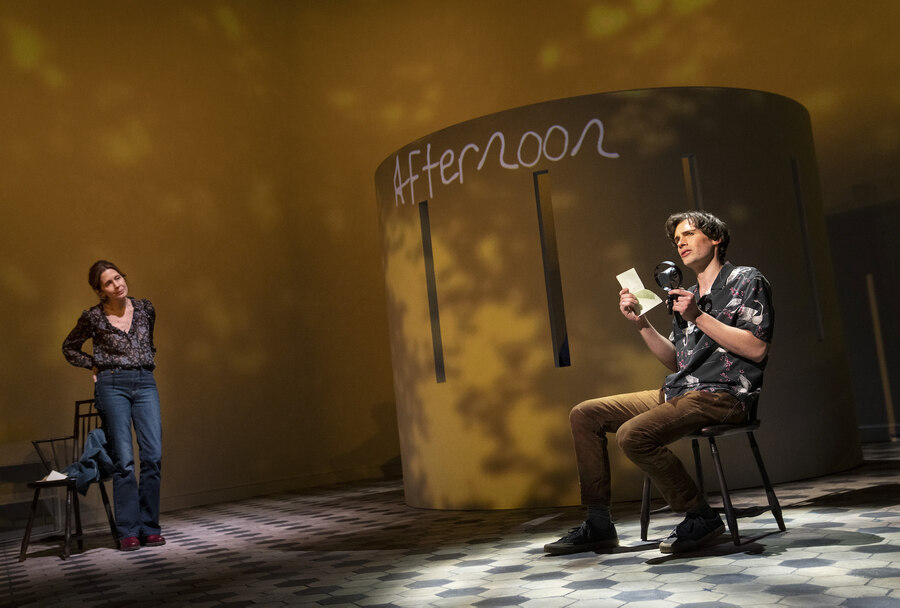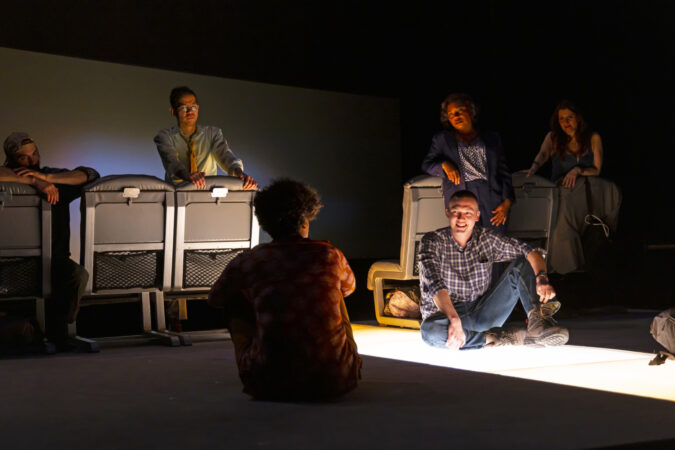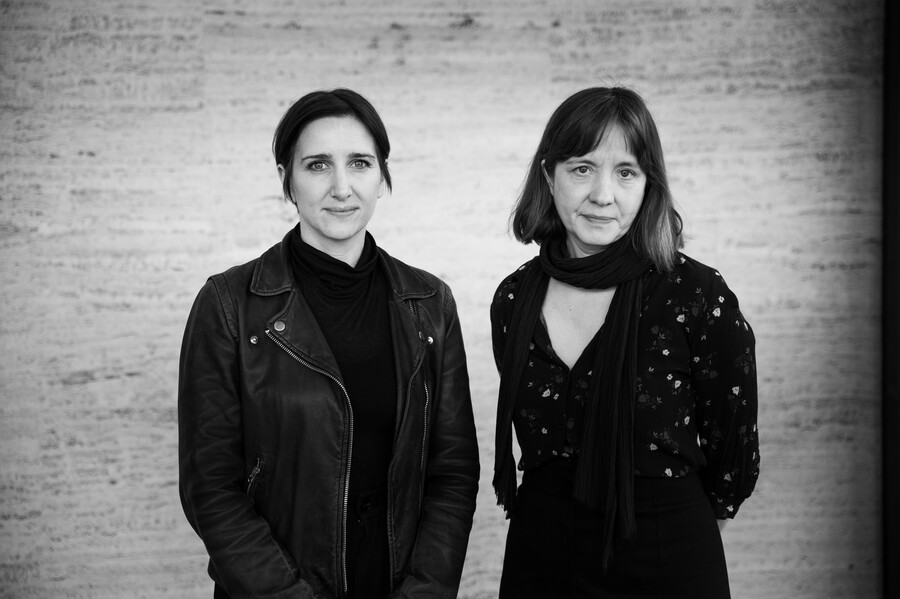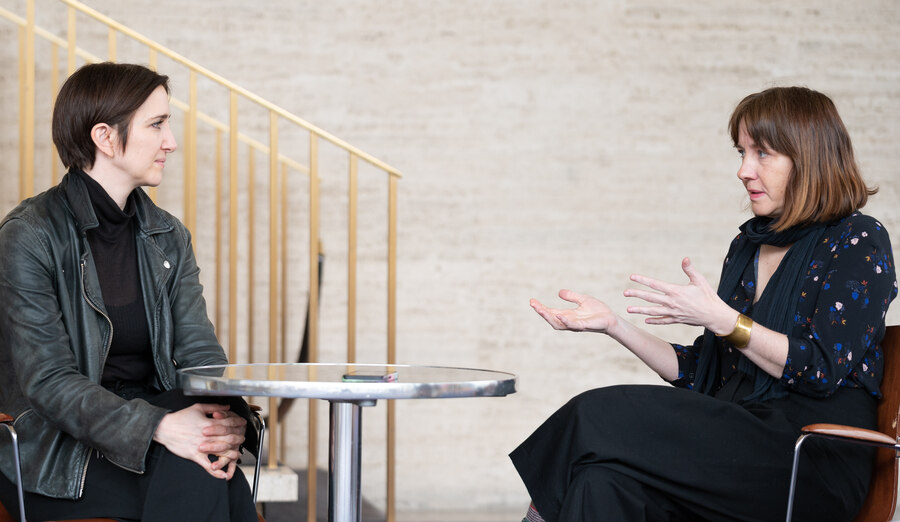What do directors direct? Not just actors and designers, of course, but also audiences; among other things, they direct our attention (or in some cases fail to).
In two new plays now running Off-Broadway, the work of the directors is particularly instrumental and effective: In Letters From Max, a ritual, Sarah Ruhl’s memoir of her time mentoring and befriending a cancer-doomed young poet named Max Ritvo (at Signature Theatre through March 26), three performers inhabit a space that is unequal parts poetry reading, memory play, and in-the-moment medical drama, and director Kate Whoriskey’s sensitive, fine-grained work is evident everywhere. The same can be said of director Tyne Rafaeli’s work on Keith Bunin’s The Coast Starlight (at Lincoln Center Theater through April 16), set on a California train in which six very different travelers mostly fail to connect—except, crucially, in the play’s virtual, might-have-been multiverse conception, where they enact a crazy-quilt of life-changing interpersonal narratives.
Both intermissionless plays move freely between direct address and character scenes, and between philosophical abstraction and quotidian detail; both coincidentally incorporate rotating set pieces that signify the passage of time; and both are the latest efforts by two of New York’s most in-demand freelance directors of new plays. I associate both Whoriskey and Rafaeli more with naturalist works than non-realistic ones like Letters From Max and The Coast Starlight. So that’s where I started our recent conversation in the lobby of Lincoln Center Theater.
ROB WEINERT-KENDT: Kate, I know you mainly as Lynn Nottage’s director, from Ruined to Sweat to Clyde’s, and Tyne, I think of your work on the single-set, real-time drama Selling Kabul. I know that both of your résumés include many non-naturalistic plays as well. Do you approach these different kinds of plays differently?
KATE WHORISKEY: I don’t ever think of it like that when I get a script. Sarah’s play is a series of letters that she wrote with one of her students, Max, who was this incredibly brilliant mind. They’re both writers, and Max died of cancer when he was 25, so it’s the process of his physical decline and his development as a writer, working concurrently. To me, what was interesting was trying to find the core design element for that idea. And then, what is the design when they’re at Yale, when they’re in the restaurant, and the 1,000 different places they could be? One of the things we did is, we took a step away and figured out: Well, poetry is the distillation of language, so what is a kind of visual distillation? We decided to create a zoetrope onstage, so we’re looking at little windows into the life of a person. That was the visual metaphor—which, in fact, nobody has gotten, interestingly.
TYNE RAFAELI: It sounds like we had a different kind of challenge; you had to bridge multiple locations and different environments, and I am in one environment, a train. My characters go on a 36-hour train journey in 95 minutes, so we had to build that sense of time and distance being traversed, and how profound that is in terms of where they’re traveling—through the West—the mythology of that and how to embody that in a theatrical way. But similarly to Kate, when I get a script, I don’t categorize it in those ways, or label it as literal or non-literal. I don’t think about my process as hugely different. You just are responding to what the play is asking of you.

Both plays get very creative with transitions, in their various ways.
KATE: That’s my favorite thing to do. I do love a transition; it makes me very happy.
TYNE: We had this thing in rehearsal where—you know “Tradition” from Fiddler? We would sing that chorus but say “Transition!”
KATE: It’s the one thing in theatre where you’re like, Oh, I can solve this; I have lighting, I have video. You have all of these wonderful tools so that you can just make something.
TYNE: And sometimes it allows you to do storytelling that the playwright didn’t necessarily know was there. Even if it is in real time, even if it is quote-unquote literal, there are transitions where you can pull out deeper metaphors and transcend even what the playwright knew they were writing. That’s really exciting to find together.
Both of these plays feature a lot of direct address, interspersed with dialogue scenes. Can you talk about how you built those two elements and put them together?
KATE: In Letters From Max, Jessica [Hecht] is responsible for having a relationship with the audience and pulling them through it, and also being in relationship to Max. We played with, what is Max’s access to the audience? In initial previews, we tried full out, full contact, and that didn’t seem right. It seems to me that whoever has the direct address also has the narrative. In the case of Letters From Max, because Max is not able to help us shape the play, there has to be a certain level of acknowledgment that this is Sarah’s selection and narration of their relationship.
TYNE: In our case, it was a grand experiment that Keith was really involved in. The way Keith has created a relationship to the audience is really fulfilling, especially now, because it’s made for the theatre—there’s no other medium that it can be. There is something deeply fulfilling about having that direct relationship to the audience. And how we marry that in our play with being as present tense as possible—it was really a kind of tricky thing we had to learn. This is not a reflective retelling of something; this is, “I am in the present even as I’m commenting on it.” That happens to a lot of us: When something significant happens to us and we retell it, we relive it as we retell it. That was a framework the actors and I created together, that there is no sense of past and retelling; they are absolutely in the present, and they all have questions they’re trying to figure out as to why they’re reliving this particular train journey. That was really helpful, just to keep it as urgent and active as possible without denying that relationship to the audience.
I think Hal Prince used to say he couldn’t direct a show unless he knew what the metaphor of the piece was. Does that ring a bell for you?
KATE: I would never think, “What is the metaphor of this?” To me it feels like: What is the meaning of the play, and what is the structure of the play? What is at its essence? If I know that, then I can make all sorts of decisions.
TYNE: Julie Taymor talks about the ideograph she finds for every play. I feel like the essence, the metaphor, the ideograph—it’s actually all trying to answer the same question, which is, what is the deepest core of this? For this play, I would not necessarily say this was a direct metaphor, but the idea that these six people are clinging on to each other for dear life, and need each other deeply to rebuild their lives and find their next steps—the idea of them being on a raft, the train being a raft, and them having to hold on to each other felt like…I don’t know if that’s a metaphor, an essence, an ideograph. But it’s a feeling. It’s a feeling of: What is a civic space that we share? What is a liminal space where you’re going from point A to point B? So I feel like we’re all trying just to drill down to, what is the deepest thing the play is asking us? And for me, it’s more visceral than necessarily cerebral.

You two are working on similar, if not quite parallel career tracks—i.e., you are both freelance directors who work mostly on new plays. Do you feel competitive, if not necessarily with each other directly, then with others in the community? Put another way, is the new-play scene sufficiently booming to keep you both plenty busy?
TYNE: For me, freelance life is never, oh, there are just going to be scripts for days…
KATE: And they’re all going to be great.
TYNE: I don’t think that’s anyone’s experience of a freelance life! But I would say that I’m continually moved by my collaborators’ development and tenacity and hunger and commitment to form. This is an indirect way of answering your question, because I think you said something that was really interesting that feels really important to me. The idea of community versus competition is something that I have been thinking a lot about. I do feel like so many of the conversations in the pandemic were breaking down this idea of competition and scarcity. I don’t know how you feel, Kate, but I feel that we’re in a kind of new and important phase where directors especially, who never get to hang out with each other, feel like we all are trying to build community in a way that I don’t feel was as present pre-pandemic. There’s dialogue happening, and the idea of competition just doesn’t feel like the right way of describing how I feel about the community of directors in my life.
KATE: The truth is, you and I are not in competition in the sense of, like, you could be rude to me, I could be rude to you, and that would get us nowhere, right? There’s no reason for it. I do think, pre-pandemic, people stayed in their lane. And I agree that people are reaching out a little bit more; people are aware that in fact there’s a power structure that is going to make choices about who gets what job, and that’s one thing that we have no control over. I’ve always found playwrights to be so lovely with each other—they’re always like, “Oh my God, great work!” They recognize how painful it is to make work, that you often get bad reviews, you sometimes get great reviews, and they support each other. And directors have been not like that in my experience of directors. It has felt silent and…
TYNE: Siloed off from each other.
KATE: And a little competitive, but that doesn’t make any sense. I do think now there is an understanding that we’re not in control, and that we’re all going through things and we’re all trying to do really good work.

Do you feel like it’s a good time for new plays?
KATE: I don’t think there is an audience, if I’m honest. I think it’s a struggle. I thought quite a bit in the 17 months we had off about what is lost, and it feels to me like as a culture, we’ve been in a kind of sandstorm and everyone has their eyes closed. Now everyone’s just trying to open their eyes, and they still have sand in their eyes. And they’re not quite at the point where they’re ready to hear a story. I’ll be honest, I think they’re at a place where story has betrayed them. Where the concept of, let’s go tell a story, let’s find meaning—we just went through a time where there was no meaning, and so many people died that shouldn’t have died. It was just so chaotic.
It’s interesting to me that every single storytelling platform is not doing well: movies, TV, theatre. We’re all struggling, and I think we’re all struggling because I think culturally we’re at a point where there’s a lack of trust. Also I think people are more comfortable with shreds of things; I think that’s why social media is taking off, because you don’t have to sit and process a thought together. And I don’t think, frankly, that story feels like a sense-making action. I don’t think people necessarily believe in that right now.
TYNE: Which is why Dadaism was born in a kind of terrible postwar era, or Beckett. I like those kind of movements. I don’t want to equate the pandemic to a war or make false equivalencies, but we are still in post-traumatic shock, and it’s going to take a long time to understand that. To piggyback on what Kate was saying about story, I also feel like intimacy is really hard. I think it’s really hard for people to sit in a room together, to be off their phones and be asked to drop into their bodies. I feel like it’s just a harder experience; people are antsy, or they want to be distracted, they want to move. It’s such a moving and strange paradox for me that the very thing we were craving during the pandemic—that intimacy, that community, to be in public places with people—is also what is hardest for us to restore. That somehow it’s easier for us, unfortunately, to kind of isolate and atomize and be away from each other. It’s really hard asking an audience to come in and be concentrated for 95 minutes and let your heartbeat start connecting to other people’s heartbeats. It’s just hard.
KATE: Time is such a huge conversation. I saw the Pina Bausch at BAM, and it was really uncomfortable. Basically, she has several dances, and then at the end of the evening, she repeats the main concepts of the dance, so it’s these four dances again, truncated. And I could feel the audience go, “Oh my God, I’ve already seen this.” They were really, really not willing. Part of it is that we have an edit button, like all of us are, and our buttons are very tight. But it’s incredible that it was two-and-a-half hours of genius work, and people were restless.
TYNE: I will say, even though I really agree with Kate that asking an audience to come to a new play and asking for their time is really hard, and it’s a tough time for the artists who are doing it. So when an audience does give you their time and attention these days, it feels somehow even more powerful. Though it’s more challenging to create, the power of it feels somehow more acute.
KATE: When I directed Clyde’s, it was the first thing after the pandemic, and I remember sitting in an audience and there was a guy who was just doing this incredible belly laugh; it was so sweet. And I just started to cry. Because I really think, we have lost that—that thing of, I’m seeing my play differently because you were responding to it. There’s a sweetness to what you learn, and there’s kind of democracy. It’s not just, “This is my point of view.” I learn by watching how other people are watching it, and the delight of that. I do think that is something that’s starting to come alive again. I will also say, in terms of Sarah’s play, there are nights where a lot of the audience is weeping, and they’re weeping together somehow, in a way that feels communal. Like when one person releases, then someone else releases, and you can actually feel this collective grief. So I think the power of the experience is still there, and the desire and the need to reach to people and say, “I have your back, come in again”—I think it is our job. I think it’s fair that people are bridling against the experience a little bit right now; I think it’s up to us to be more inclusive, to actually open the door. I think theatre is still just a bit closed and bougie. So it’s like, How do we make it a more universal experience?
TYNE: I directed this play Epiphany last year, which was about a group of people who come together to celebrate the feast of Epiphany, but no one knows what Epiphany is. It was a real investigation about what ritual is in our lives. What you’re describing in terms of collective grief—that is why we have funerals or shivas, whatever your death rites are in your culture. My father passed away a couple years ago, and I don’t come from a spiritual context in terms of my family, and yet we did a kind of pseudo-shiva for him. I was so struck by how much that framework was needed and valuable in order for me and my family to process that loss. And it really made me reflect on what I do in a new way in terms of the ritual of theatre, and that we’re processing our own lives in a kind of collective, ritualized experience without even knowing that we’re consciously doing that. That’s the best we can do, and there is a need for that. But now, as Kate says, it’s about how can we as a field and an industry try and invite people back and open the doors and make it easier for them to come?
Rob Weinert-Kendt (he/him) is the editor-in-chief of American Theatre. rwkendt@tcg.org


